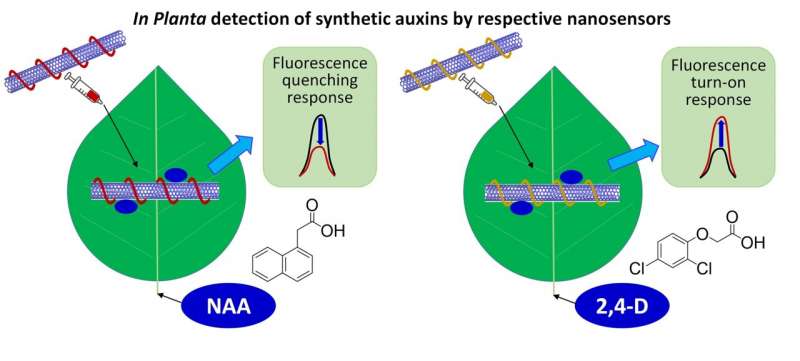
Researchers from the Disruptive
& Sustainable Technologies for Agricultural Precision (DiSTAP)
Interdisciplinary Research Group (IRG) of Singapore-MIT Alliance for Research
and Technology (SMART), MIT's research enterprise in Singapore and their local
collaborators from Temasek Life Sciences Laboratory (TLL) and Nanyang
Technological University (NTU) have developed the first ever nanosensor to
enable rapid testing of synthetic auxin plant hormones. The novel nanosensors
are safer and less tedious than existing techniques for testing plants'
response to compounds such as herbicide, and can be transformative in improving
agricultural production and our understanding of plant growth.
The scientists designed sensors for two plant hormones—1-naphthalene acetic acid (NAA) and 2,4-dichlorophenoxyacetic acid (2,4D)—which are used extensively in the farming industry for regulating plant growth and as herbicides respectively. Current methods to detect NAA and 2,4D cause damage to plants, and are unable to provide real-time in vivo monitoring and information.
Based on the concept of corona phase molecular recognition (CoPhMoRe) pioneered by the Strano Lab at SMART DiSTAP and Massachusetts Institute of Technology (MIT), the novel sensors are able to detect the presence of NAA and 2,4D in living plants at a swift pace, providing plant information in real time, without causing any harm. The team has successfully tested both sensors on a number of everyday crops including pak choi, spinach and rice across various planting mediums such as soil, hydroponic, and plant tissue culture.
Explained in a paper titled "Nanosensor Detection of Synthetic Auxins In Planta using Corona Phase Molecular Recognition" published in the prestigious journal ACS Sensors, the research can facilitate more efficient use of synthetic auxins in agriculture and hold tremendous potential to advance plant biology study.
"Our CoPhMoRe technique has previously been used to detect compounds such as hydrogen peroxide and heavy-metal pollutants like arsenic—but this is the first successful case of CoPhMoRe sensors developed for detecting plant phytohormones that regulate plant growth and physiology, such as sprays to prevent premature flowering and dropping of fruits," says DiSTAP co-lead Principal Investigator Professor Michael Strano and Carbon P. Dubbs Professor of Chemical Engineering at MIT, who leads The Strano Lab at MIT. "This technology can replace current state-of-the-art sensing methods which are laborious, destructive, and unsafe."
Of the two sensors developed by the research team, the 2,4D nanosensor also showed the ability to detect herbicide susceptibility, enabling farmers and agricultural scientists to quickly find out how vulnerable or resistant different plants are to herbicides without the need to monitor crop or weed growth over days. "This could be incredibly beneficial in revealing the mechanism behind how 2,4D works within plants and why crops develop herbicide resistance," says DiSTAP and TLL Principal Investigator Dr. Rajani Sarojam.
"Our research can help the industry gain a better understanding of plant growth dynamics and has the potential to completely change how the industry screens for herbicide resistance, eliminating the need to monitor crop or weed growth over days," says Dr. Mervin Chun-Yi Ang, Research Scientist at DiSTAP. "It can be applied across a variety of plant species and planting mediums, and could easily be used in commercial setups for rapid herbicide susceptibility testing, such as urban farms."
NTU Professor Mary Chan-Park Bee Eng says, "Using nanosensors for in planta detection eliminates the need for extensive extraction and purification processes, which saves time and money. They also use very low-cost electronics, which makes them easily adaptable for commercial setups."
The team says their research can lead to future development of real-time nanosensors for other dynamic plant hormones and metabolites in living plants as well.
The development of the nanosensor, optical detection system, and image processing algorithms for this study was done by SMART, NTU and MIT, while TLL validated the nanosensors and provided knowledge of plant biology and plant signaling mechanisms. The research is carried out by SMART and supported by NRF under its Campus for Research Excellence And Technological Enterprise (CREATE) program.

 Previous page
Previous page Back to top
Back to top







